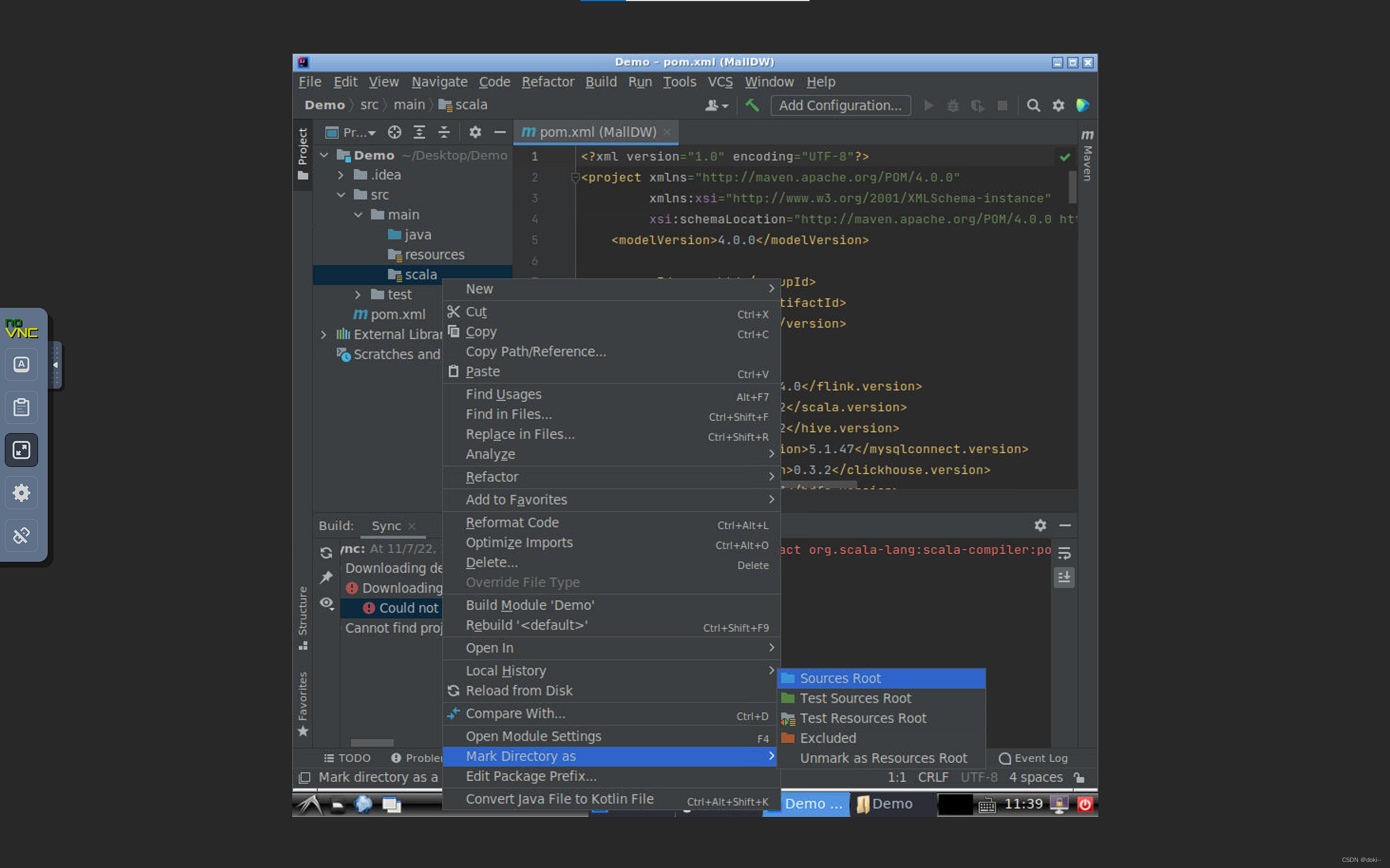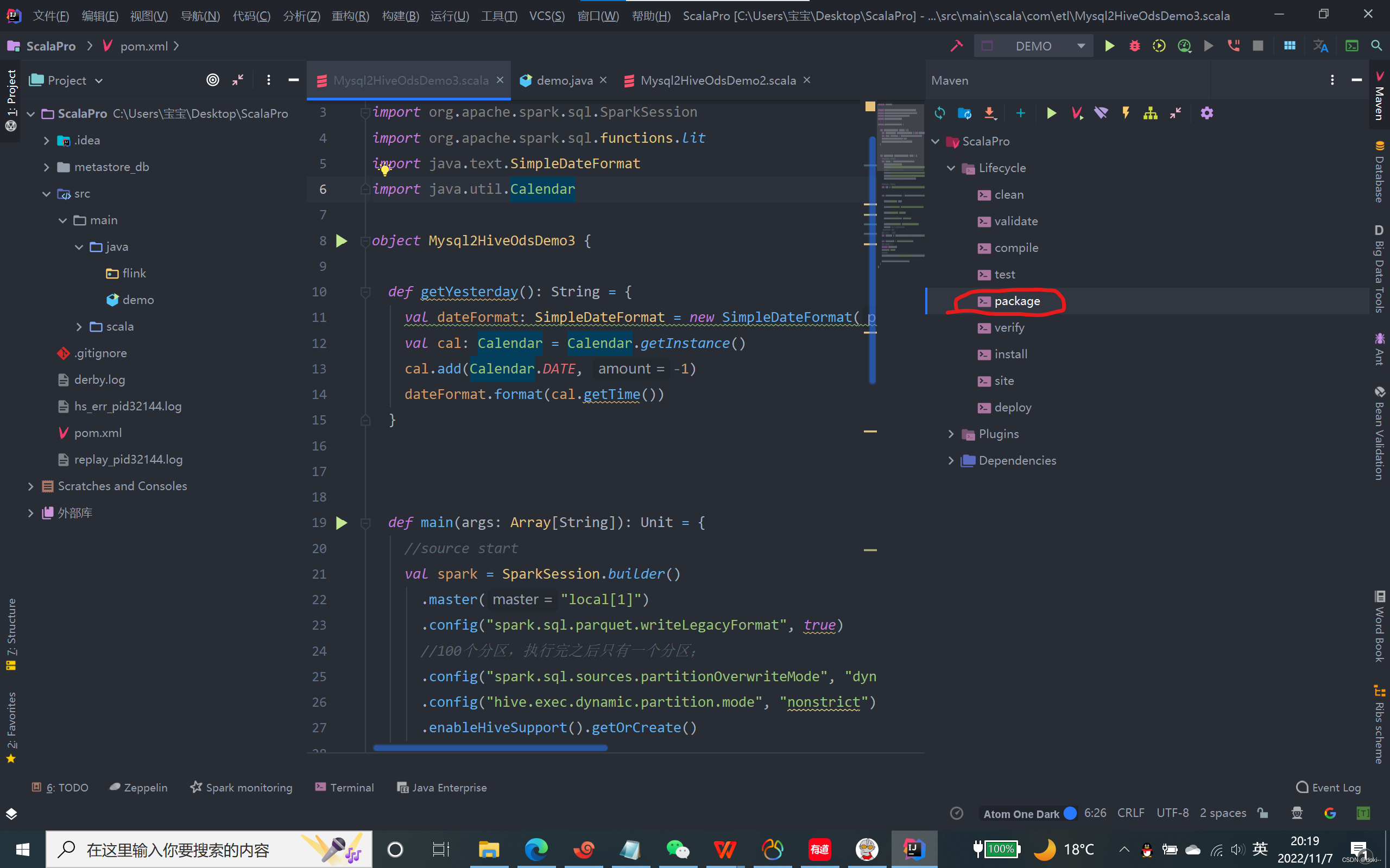编写Scala代码,使用Spark讲Mysql数据表中的数据抽取到Hive的ODS层
抽取MySQL的metast库中Production表的全量数据进入Hive的ods库中表production,字段排序、类型不变,同时添加静态分区,分区字段类型为String,且值为当前日期的前一天日期(分区字段格式为yyyyMMdd)。
使用IDEA创建maven项目
配置pom文件
<project xmlns="http://maven.apache.org/POM/4.0.0" xmlns:xsi="http://www.w3.org/2001/XMLSchema-instance" xsi:schemaLocation="http://maven.apache.org/POM/4.0.0 http://maven.apache.org/maven-v4_0_0.xsd"> <modelVersion>4.0.0</modelVersion> <groupId>com.tledu</groupId> <artifactId>llll</artifactId> <version>1.0-SNAPSHOT</version> <name>${project.artifactId}</name> <description>My wonderfull scala app</description> <inceptionYear>2018</inceptionYear> <licenses> <license> <name>My License</name> <url>http://....</url> <distribution>repo</distribution> </license> </licenses> <properties> <maven.compiler.source>1.8</maven.compiler.source> <maven.compiler.target>1.8</maven.compiler.target> <encoding>UTF-8</encoding> <scala.version>2.11.11</scala.version> <scala.compat.version>2.11</scala.compat.version> <spec2.version>4.2.0</spec2.version> </properties> <dependencies> <dependency> <groupId>org.scala-lang</groupId> <artifactId>scala-library</artifactId> <version>${scala.version}</version> </dependency> <dependency> <groupId>org.apache.spark</groupId> <artifactId>spark-core_${scala.compat.version}</artifactId> <version>2.3.2</version> <scope>provided</scope> </dependency> <dependency> <groupId>org.apache.spark</groupId> <artifactId>spark-sql_${scala.compat.version}</artifactId> <version>2.3.2</version> <scope>provided</scope> </dependency> <dependency> <groupId>org.apache.spark</groupId> <artifactId>spark-hive_2.11</artifactId> <version>2.0.2</version> <scope>provided</scope> </dependency> <dependency> <groupId>mysql</groupId> <artifactId>mysql-connector-java</artifactId> <version>8.0.23</version> </dependency> <!-- Test --> <dependency> <groupId>junit</groupId> <artifactId>junit</artifactId> <version>4.12</version> <scope>test</scope> </dependency> <dependency> <groupId>org.scalatest</groupId> <artifactId>scalatest_${scala.compat.version}</artifactId> <version>3.0.5</version> <scope>test</scope> </dependency> <dependency> <groupId>org.specs2</groupId> <artifactId>specs2-core_${scala.compat.version}</artifactId> <version>${spec2.version}</version> <scope>test</scope> </dependency> <dependency> <groupId>org.specs2</groupId> <artifactId>specs2-junit_${scala.compat.version}</artifactId> <version>${spec2.version}</version> <scope>test</scope> </dependency> </dependencies> <build> <sourceDirectory>src/main/scala</sourceDirectory> <testSourceDirectory>src/test/scala</testSourceDirectory> <plugins> <plugin> <!-- see http://davidb.github.com/scala-maven-plugin --> <groupId>net.alchim31.maven</groupId> <artifactId>scala-maven-plugin</artifactId> <version>3.3.2</version> <executions> <execution> <goals> <goal>compile</goal> <goal>testCompile</goal> </goals> <configuration> <args> <arg>-dependencyfile</arg> <arg>${project.build.directory}/.scala_dependencies</arg> </args> </configuration> </execution> </executions> </plugin> <plugin> <groupId>org.apache.maven.plugins</groupId> <artifactId>maven-surefire-plugin</artifactId> <version>2.21.0</version> <configuration> <!-- Tests will be run with scalatest-maven-plugin instead --> <skipTests>true</skipTests> </configuration> </plugin> <plugin> <groupId>org.scalatest</groupId> <artifactId>scalatest-maven-plugin</artifactId> <version>2.0.0</version> <configuration> <reportsDirectory>${project.build.directory}/surefire-reports</reportsDirectory> <junitxml>.</junitxml> <filereports>TestSuiteReport.txt</filereports> <!-- Comma separated list of JUnit test class names to execute --> <jUnitClasses>samples.AppTest</jUnitClasses> </configuration> <executions> <execution> <id>test</id> <goals> <goal>test</goal> </goals> </execution> </executions> </plugin> <plugin> <artifactId>maven-assembly-plugin</artifactId> <configuration> <descriptorRefs> <descriptorRef>jar-with-dependencies</descriptorRef> </descriptorRefs> </configuration> <executions> <execution> <id>make-assembly</id> <phase>package</phase> <goals> <goal>assembly</goal> </goals> </execution> </executions> </plugin> </plugins> </build></project>导入scala
我这里演示用的是Unbanto,操作步骤一样

 点击+号去添加,这里注意scala版本号要与pom配置文件中的一致
点击+号去添加,这里注意scala版本号要与pom配置文件中的一致



创建一个scala目录并将它标记为根目录,在scala里新建一个object
编程过程如下
object demo01 { def getYesterday(): String = { val dateFormat: SimpleDateFormat = new SimpleDateFormat("yyyyMMdd") val cal: Calendar = Calendar.getInstance() cal.add(Calendar.DATE, -1) dateFormat.format(cal.getTime()) } def main(args: Array[String]): Unit = { //source start val spark = SparkSession.builder() .master("local[1]") .config("spark.sql.parquet.writeLegacyFormat", true) //100个分区,执行完之后只有一个分区; .config("spark.sql.sources.partitionOverwriteMode", "dynamic")//动态分区 .config("spark.sql.legacy.parquet.int96RebaseModeInWrite","LEGACY") .config("hive.exec.dynamic.partition.mode", "nonstrict") .enableHiveSupport().getOrCreate() //spark连接mysql val url = s"jdbc:mysql://IP地址:3306/shtd_industry?useUnicode=true&characterEncoding=utf8&useSSL=false" val readerCustomerInf = spark.read.format("jdbc") .option("url", url) .option("driver", "com.mysql.jdbc.Driver") .option("user", "root") .option("password", "123456") .option("dbtable", "数据库表名") .load() //转换为DataFrame //source end //增加分区字段 etl val addPtDF = readerCustomerInf.withColumn("etl_date", lit(getYesterday())) val tableName = "hive表名" //切换hive的数据库 import spark.sql sql("use ods") //sink addPtDF.write.mode("overwrite").partitionBy("etl_date").saveAsTable(tableName).formatted("orc") spark.table(tableName).show() }}将编写好的代码打包发送到linux中

在集群上上传你打好的包
通常使用rz指令上传
可以写一个脚本运行你的包
vi spark.sh
/opt/module/spark-3.1.1-yarn/bin/spark-submit \--class 要运行的类名 \--master yarn \--deploy-mode client \--driver-memory 2g \--executor-memory 1g \--executor-cores 2 \/jar包的地址/这里是你的jar包
保存退出
sh spark.sh 运行脚本
Mysql数据就导入HIVE数据库的ods层中了
来源地址:https://blog.csdn.net/qq_41289004/article/details/127737908




